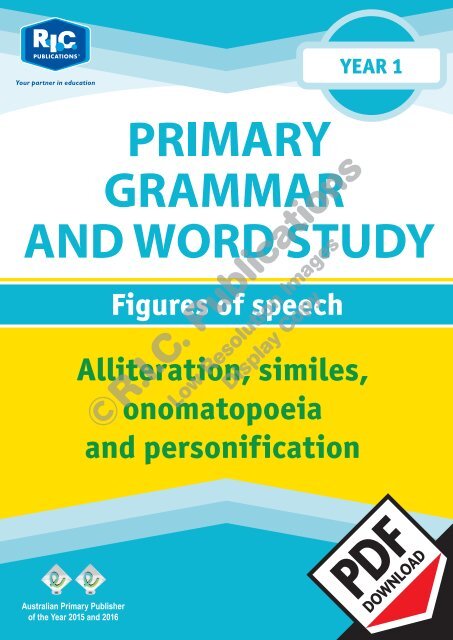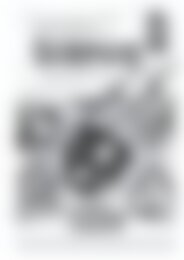RIC-20229 Primary Grammar and Word Study Year 1 – Figures of Speech
Create successful ePaper yourself
Turn your PDF publications into a flip-book with our unique Google optimized e-Paper software.
©R.I.C. Publications<br />
Low Resolution Images<br />
Display Copy
<strong>Primary</strong> grammar <strong>and</strong> word study (Book B)<br />
Published by R.I.C. Publications ® 2008<br />
Copyright © by R.I.C. Publications ® 2008<br />
This master may only be reproduced by the<br />
original purchaser for use with their class(es). The<br />
publisher prohibits the loaning or onselling <strong>of</strong> this<br />
master for the purposes <strong>of</strong> reproduction.<br />
<strong>RIC</strong><strong>–</strong><strong>20229</strong><br />
Copyright Notice<br />
Blackline masters or copy masters are published <strong>and</strong><br />
sold with a limited copyright. This copyright allows<br />
publishers to provide teachers <strong>and</strong> schools with a<br />
wide range <strong>of</strong> learning activities without copyright<br />
being breached. This limited copyright allows the<br />
purchaser to make sufficient copies for use within<br />
their own education institution. The copyright is not<br />
transferable, nor can it be onsold. Following these<br />
instructions is not essential but will ensure that you,<br />
as the purchaser, have evidence <strong>of</strong> legal ownership<br />
to the copyright if inspection occurs.<br />
For your added protection in the case <strong>of</strong> copyright<br />
inspection, please complete the form below. Retain<br />
this form, the complete original document <strong>and</strong> the<br />
invoice or receipt as pro<strong>of</strong> <strong>of</strong> purchase.<br />
Name <strong>of</strong> Purchaser:<br />
Date <strong>of</strong> Purchase:<br />
Supplier:<br />
School Order# (if applicable):<br />
Signature <strong>of</strong> Purchaser:<br />
©R.I.C. Publications<br />
Low Resolution Images<br />
Display Copy<br />
Internet websites<br />
In some cases, websites or specific URLs may be recommended. While these are checked <strong>and</strong> rechecked at the time <strong>of</strong> publication,<br />
the publisher has no control over any subsequent changes which may be made to webpages. It is strongly recommended that the class<br />
teacher checks all URLs before allowing students to access them.<br />
View all pages online<br />
PO Box 332 Greenwood Western Australia 6924<br />
Website: www.ricpublications.com.au<br />
Email: mail@ricgroup.com.au
<strong>Primary</strong> grammar <strong>and</strong><br />
word study <strong>–</strong> Book B<br />
Foreword<br />
<strong>Primary</strong> grammar <strong>and</strong> word study is a series <strong>of</strong> seven books designed<br />
to introduce students to parts <strong>of</strong> speech, ways to underst<strong>and</strong> <strong>and</strong> choose<br />
words, punctuation <strong>and</strong> figures <strong>of</strong> speech.<br />
Titles in this series:<br />
• <strong>Primary</strong> grammar <strong>and</strong> word study Book A (Ages 5<strong>–</strong> 6)<br />
• <strong>Primary</strong> grammar <strong>and</strong> word study Book B (Ages 6<strong>–</strong>7)<br />
• <strong>Primary</strong> grammar <strong>and</strong> word study Book C (Ages 7<strong>–</strong>8)<br />
• <strong>Primary</strong> grammar <strong>and</strong> word study Book D (Ages 8<strong>–</strong>9)<br />
• <strong>Primary</strong> grammar <strong>and</strong> word study Book E (Ages 9<strong>–</strong>10)<br />
• <strong>Primary</strong> grammar <strong>and</strong> word study Book F (Ages 10<strong>–</strong>11)<br />
• <strong>Primary</strong> grammar <strong>and</strong> word study Book G (Ages 11<strong>–</strong>12)<br />
Teachers notes .............................................. iv <strong>–</strong> v<br />
English curriculum links ....................................... v<br />
Literacy character explanation ...................... vi <strong>–</strong> vii<br />
Checklists.................................................... viii <strong>–</strong> xi<br />
Parts <strong>of</strong> speech .............................................. 2<strong>–</strong>33<br />
Nouns .............................................................. 2<strong>–</strong>5<br />
Verbs .............................................................. 6<strong>–</strong>11<br />
Adjectives..................................................... 12<strong>–</strong>17<br />
Adverbs ........................................................ 18<strong>–</strong>21<br />
Pronouns ...................................................... 22<strong>–</strong>25<br />
Conjunctions ................................................ 26<strong>–</strong>27<br />
Determiners ................................................. 28<strong>–</strong>31<br />
Prepositions ................................................ 32<strong>–</strong>33<br />
Underst<strong>and</strong>ing <strong>and</strong> choosing words ........... 34<strong>–</strong>61<br />
<strong>Word</strong>s that are similar ................................... 34<strong>–</strong>49<br />
Homographs ................................................. 34<strong>–</strong>35<br />
Homophones ................................................ 36<strong>–</strong>37<br />
<strong>Word</strong> groups ................................................. 38<strong>–</strong>49<br />
Contents<br />
<strong>Word</strong>s that change ........................................ 50<strong>–</strong>53<br />
Plurals .......................................................... 50<strong>–</strong>53<br />
<strong>Word</strong>s <strong>and</strong> their meanings ............................ 54<strong>–</strong>57<br />
Synonyms .................................................... 54<strong>–</strong>55<br />
Antonyms ..................................................... 56<strong>–</strong>57<br />
Confused words ........................................... 58<strong>–</strong>61<br />
©R.I.C. Publications<br />
Low Resolution Images<br />
Display Copy<br />
Punctuation .................................................. 62<strong>–</strong>75<br />
Full stops, question marks <strong>and</strong><br />
exclamation marks ....................................... 62<strong>–</strong>63<br />
Capital letters ............................................... 64<strong>–</strong>65<br />
Commas ....................................................... 66<strong>–</strong>69<br />
Apostrophes ................................................. 70<strong>–</strong>73<br />
Quotation marks ........................................... 74<strong>–</strong>75<br />
<strong>Figures</strong> <strong>of</strong> speech ......................................... 76<strong>–</strong>83<br />
Alliteration .................................................... 76<strong>–</strong>77<br />
Similes ......................................................... 78<strong>–</strong>79<br />
Onomatopoeia .............................................. 80<strong>–</strong>81<br />
Personification .............................................. 82<strong>–</strong>83<br />
R.I.C. Publications ® www.ricpublications.com.au iii<br />
<strong>Primary</strong> grammar <strong>and</strong> word study
<strong>Figures</strong> <strong>of</strong> speech checklist<br />
Name <strong>of</strong> student Alliteration Similes Onomatopoeia Personification<br />
©R.I.C. Publications<br />
Low Resolution Images<br />
Display Copy<br />
R.I.C. Publications ® www.ricpublications.com.au xi<br />
<strong>Primary</strong> grammar <strong>and</strong> word study
<strong>Figures</strong> <strong>of</strong> speech<br />
Alliteration<br />
Focus<br />
Alliteration<br />
Definition<br />
• Alliteration is the repetition <strong>of</strong> a sound at the<br />
beginning <strong>of</strong> words.<br />
Example:<br />
Ten tiny tadpoles talked to each other.<br />
Explanation<br />
• Alliteration occurs when the same sound or sound<br />
group is repeated at the commencement <strong>of</strong> two or<br />
more stressed syllables <strong>of</strong> a word group (usually the<br />
first sound in a word).<br />
• Activities using alliteration are <strong>of</strong>ten used when<br />
introducing initial sounds to young students.<br />
• Alliteration is <strong>of</strong>ten used in nursery rhymes <strong>and</strong><br />
poetry.<br />
Example:<br />
Baa baa black sheep ...<br />
• Alliteration can make rhymes, poems or songs<br />
easier to remember.<br />
• Alliteration is a useful writing tool to create special<br />
effects.<br />
Worksheet information<br />
• Read <strong>and</strong> discuss the explanation, give some<br />
examples <strong>and</strong> ask the students for some examples.<br />
• Read the text in Question 1 with the students,<br />
assisting with any unfamiliar vocabulary.<br />
• Using a coloured pencil, students underline any<br />
words beginning with ‘s’. Check answers before<br />
proceeding to Question 2. (Interesting ‘s’ words<br />
can be added to student dictionaries to use during<br />
writing activities.)<br />
• Look at <strong>and</strong> discuss each picture, highlighting<br />
any words which begin with ‘f’ <strong>and</strong> ‘h’. Assist with<br />
writing unfamiliar words.<br />
• Read <strong>and</strong> discuss the sentence beginnings in<br />
Question 3 <strong>and</strong> ask for suggestions for words to<br />
complete the sentences. Ensure that the students<br />
know which beginning sound they should be using.<br />
(Allow the students to colour the picture after<br />
completing the worksheet.)<br />
Ideas for further practice<br />
• Identify alliterative words in texts used during shared<br />
reading sessions.<br />
• Learn to say tongue twisters such as ‘Peter Piper<br />
picked a peck <strong>of</strong> pickled peppers’.<br />
• Select individual students to share their answers to<br />
Question 3 <strong>and</strong> any other interesting alliteration they<br />
create or encounter.<br />
Answers<br />
1. (a) Teacher check<br />
(b) On Saturday, the swirling sea swept six silly<br />
seals to the seashore. They sat on the s<strong>of</strong>t<br />
s<strong>and</strong>. Some were sad <strong>and</strong> some were sick.<br />
On Sunday, the Seal Search <strong>and</strong> Rescue Squad<br />
saved them <strong>and</strong> scurried them back out to sea.<br />
The seals swam safely out <strong>of</strong> sight.<br />
2.<strong>–</strong>3. Teacher check<br />
©R.I.C. Publications<br />
Low Resolution Images<br />
Display Copy<br />
<strong>Primary</strong> grammar <strong>and</strong> word study 76<br />
www.ricpublications.com.au R.I.C. Publications ®
Alliteration<br />
Alliteration occurs when the same sound is<br />
repeated at the beginning <strong>of</strong> words.<br />
1. (a) Read the sentences.<br />
On Saturday, the swirling sea swept<br />
six silly seals to the seashore. They sat<br />
on the s<strong>of</strong>t s<strong>and</strong>. Some were sad <strong>and</strong><br />
some were sick.<br />
On Sunday, the Seal Search <strong>and</strong><br />
Rescue Squad saved them <strong>and</strong><br />
scurried them back out to sea. The<br />
seals swam safely out <strong>of</strong> sight.<br />
(b) Underline all the words which begin with ‘s’.<br />
2. Write a sentence with alliteration to describe each picture.<br />
©R.I.C. Publications<br />
Low Resolution Images<br />
Display Copy<br />
3. Write words beginning with the same sound to tell what each is<br />
doing.<br />
(a) The wild wind is .<br />
(b) The dainty daisies are .<br />
(c) The quiet queen is .<br />
R.I.C. Publications ® www.ricpublications.com.au 77<br />
<strong>Primary</strong> grammar <strong>and</strong> word study
<strong>Figures</strong> <strong>of</strong> speech<br />
Similes<br />
Focus<br />
Similes<br />
Definition<br />
A simile compares one thing with another. Similes<br />
are usually introduced by the words ‘as’ or ‘like’.<br />
Example:<br />
He was as cunning as a fox.<br />
She slept like a log.<br />
Explanation<br />
• Similes are figures <strong>of</strong> speech. They are examples <strong>of</strong><br />
figurative language, as opposed to literal language.<br />
In figurative language, words are used to create<br />
mental images <strong>and</strong> impressions by comparing ideas.<br />
These comparisons help the reader to more clearly<br />
imagine the person, place or thing being described.<br />
• Writers use similes to emphasise a certain<br />
characteristic. Similies make writing more<br />
interesting, entertaining <strong>and</strong> colourful, as they <strong>of</strong>ten<br />
make a link between two unlike subjects.<br />
Example:<br />
The children ran around the playground like a pack<br />
<strong>of</strong> wild animals.<br />
Worksheet information<br />
• Read the explanation <strong>of</strong> a simile <strong>and</strong> say the<br />
example. Ask the students if they can think <strong>of</strong> any<br />
other examples.<br />
• Read the poem with the class. Discuss which word<br />
introduces a simile—‘as’. Students underline the<br />
three similes in the poem.<br />
• Students choose a noun that matches the similes in<br />
Question 2. They illustrate one <strong>of</strong> the similes.<br />
• In Question 3, students choose an adjective to<br />
complete the similes.<br />
• In Question 4, read the poem <strong>and</strong> the words in<br />
brackets with the class. Students can chose one<br />
word from each set <strong>of</strong> brackets or choose their own<br />
words to complete the simile poem about the owl.<br />
Ideas for further practice<br />
• Work with a partner to find three items in the<br />
classroom <strong>and</strong> write a similie for each.<br />
Example:<br />
The door is as strong as Superman .<br />
• Students write a simile poem about themselves in<br />
which each attribute refers to an animal.<br />
Example:<br />
I am as quiet as a mouse.<br />
I am as quick as a bat.<br />
I am as gentle as a lamb<br />
And as lazy as a cat.<br />
• Share simile poems with the class, such as My dog<br />
is as smelly as dirty socks by H Piven. Students write<br />
a review <strong>of</strong> the poem.<br />
Answers<br />
1. I am as happy as a clam<br />
And as funny as a clown.<br />
I am as playful as a kitten—<br />
I never like to frown.<br />
2. (a) toast (b) lion (c) fish (d) pancake<br />
3. (a) cold (b) cute (c) gentle<br />
4. Teacher check<br />
©R.I.C. Publications<br />
Low Resolution Images<br />
Display Copy<br />
<strong>Primary</strong> grammar <strong>and</strong> word study 78<br />
www.ricpublications.com.au R.I.C. Publications ®
Similes<br />
A simile compares one thing with another.<br />
For example, Mum was as busy as a bee.<br />
1. Underline the three similes in the poem.<br />
Me<br />
I am as happy as a clam<br />
And as funny as a clown.<br />
I am as playful as a kitten—<br />
I never like to frown.<br />
2. Write the best word for each simile.<br />
Choose one simile <strong>and</strong> draw it.<br />
fish pancake toast lion<br />
(a) as warm as<br />
(b) brave like a<br />
(c) as slippery as a<br />
(d) as flat as a<br />
3. Add a word from the list to finish each simile.<br />
(a) as<br />
(b) as<br />
(c)<br />
as ice<br />
as a button<br />
like a lamb<br />
gentle<br />
cold<br />
©R.I.C. Publications<br />
Low Resolution Images<br />
Display Copy<br />
cute<br />
4. Use words from the brackets or choose your own words to finish<br />
the poem.<br />
The owl<br />
Her eyes are as round as . (the moon/plates)<br />
Her feathers as s<strong>of</strong>t as . (a cloud/cotton wool)<br />
Her claws are as sharp as . (knives/needles)<br />
She flies when it is as dark as .<br />
(a dungeon/shadows)<br />
R.I.C. Publications ® www.ricpublications.com.au 79<br />
<strong>Primary</strong> grammar <strong>and</strong> word study
<strong>Figures</strong> <strong>of</strong> speech<br />
Onomatopoeia<br />
Focus<br />
Onomatopoeia<br />
Definition<br />
• Onomatopoeia is a word which imitates the sound<br />
<strong>of</strong> what it describes.<br />
Example:<br />
plop or zoom<br />
Explanation<br />
• <strong>Figures</strong> <strong>of</strong> speech are used to make language more<br />
interesting, memorable or surprising. There are<br />
three distinct groups: phonological figures <strong>of</strong> speech<br />
(based on sound effects); lexical figures <strong>of</strong> speech<br />
(depending for their effect on the use <strong>of</strong> words);<br />
<strong>and</strong> syntactic figures <strong>of</strong> speech (depending for their<br />
effect on sentence structure).<br />
• Phonological figures <strong>of</strong> speech include:<br />
alliteration <strong>–</strong> The use <strong>of</strong> the same sound at the<br />
beginning <strong>of</strong> words.<br />
Example:<br />
The slimy snake silently slithered.<br />
assonance <strong>–</strong> The use <strong>of</strong> internal rhyme by using<br />
the same vowel or consonant sounds within words<br />
which follow each other or are close together.<br />
Example:<br />
double trouble<br />
onomatopoeia <strong>–</strong> The use <strong>of</strong> a word that imitates<br />
what it describes.<br />
Example:<br />
the babbling <strong>of</strong> a stream<br />
Worksheet information:<br />
• Read stories such as Where does Thursday go? by<br />
Janeen Brian, Night noises by Mem Fox or any other<br />
texts which use onomatopoeia. Identify <strong>and</strong> discuss<br />
the use <strong>of</strong> words such as ‘knick, knack, kock’ <strong>and</strong><br />
‘oogle, gurgle’. Ask the students why they think the<br />
author has used these types <strong>of</strong> words in the story.<br />
• Introduce the students to the term ‘onomatopoeia’<br />
<strong>and</strong> explain that it means a word whose sound<br />
imitates its meaning. Use the books you have read<br />
to provide students with examples <strong>of</strong> these types <strong>of</strong><br />
words.<br />
• Ask students to brainstorm to list any other words<br />
they think belong in this group <strong>of</strong> words.<br />
• The worksheet identifies some words which are<br />
used to represent the sounds <strong>of</strong> things around the<br />
home. This is a basic introduction to onomatopoeia,<br />
using familiar <strong>and</strong> common words <strong>and</strong> sounds.<br />
Ideas for further practice<br />
• Students may use the word lists developed during<br />
the brainstorm to write a simple poem which uses<br />
onomatopoeia. Add appropriate artwork <strong>and</strong> display.<br />
• Create labels for display around the classroom, using<br />
onomatopoeia for everyday objects.<br />
Example:<br />
The cupboard door opens<br />
with a screech.<br />
©R.I.C. Publications<br />
Low Resolution Images<br />
Display Copy<br />
Answers:<br />
1. (a) balloon (b) clock (c) telephone<br />
(d) s<strong>of</strong>t-drink (e) doorbell<br />
2. (a) drip (b) tinkle (c) boing<br />
(d) splash<br />
<strong>Primary</strong> grammar <strong>and</strong> word study 80<br />
www.ricpublications.com.au R.I.C. Publications ®
Onomatopoeia<br />
1. Read these words. Match them to the object which<br />
would make that sound.<br />
(a) pop • •<br />
(b) tick-tock • •<br />
(c) ring, ring • •<br />
(d) fizz • •<br />
(e) ding-dong • •<br />
2. Look at these pictures. Write a word to match each things sound.<br />
(a)<br />
©R.I.C. Publications<br />
Low Resolution Images<br />
Display Copy<br />
(b) t k<br />
p<br />
(c)<br />
b<br />
(d) p h<br />
R.I.C. Publications ® www.ricpublications.com.au 81<br />
<strong>Primary</strong> grammar <strong>and</strong> word study
<strong>Figures</strong> <strong>of</strong> speech<br />
Personification<br />
Focus<br />
Personifying animals <strong>and</strong> objects<br />
Definition<br />
• Personification is a way <strong>of</strong> describing non-human<br />
things (such as animals <strong>and</strong> inanimate objects)<br />
using human traits <strong>and</strong> abilities such as such as<br />
speaking.<br />
Example:<br />
The mountain hut beckoned as the wind grabbed<br />
at my jacket.<br />
Explanation<br />
• Personification can provide a different perspective.<br />
Personifying an object or animal can help the<br />
reader underst<strong>and</strong>, sympathise, connect or react<br />
emotionally to non-human characters.<br />
Worksheet information<br />
• Personification can <strong>of</strong>ten be found in poetry.<br />
Teachers might wish to introduce this worksheet<br />
by reading some poetry to the students <strong>and</strong> talking<br />
about how the things were given human traits in the<br />
poem. Examples <strong>of</strong> some age appropriate poems<br />
include ‘Two sunflowers move in the yellow room’ by<br />
William Blake; ‘In the garden’, ‘The sky is low’ <strong>and</strong><br />
other poems by Emily Dickinson; or nursery rhymes<br />
like ‘Hey diddle diddle’ by Mother Goose.<br />
• Fables, nursery rhymes <strong>and</strong> fairy tales frequently<br />
have animals with human abilities <strong>and</strong> traits as main<br />
characters. Teachers may wish to read some <strong>of</strong><br />
these as an introduction.<br />
• Read the worksheet introduction with the students.<br />
Ask them to suggest some characters they know<br />
that are not people, but do things normally only<br />
people can do. Teachers may wish to introduce <strong>and</strong><br />
discuss the term ‘personify’ with the students.<br />
• Students select one <strong>of</strong> the characters on the<br />
worksheet or create one <strong>of</strong> their own. They give<br />
it human characteristics, such as a gender, name<br />
<strong>and</strong> personality. Using this information, they write<br />
a short story about something that might happen<br />
to this character. Encourage students to describe<br />
how the character might react, think or feel about<br />
these things, focussing on the human characteristics<br />
rather than events.<br />
Ideas for further practice<br />
• Students could write a narrative using the character<br />
they have created.<br />
• Give one-half <strong>of</strong> the students a card with an<br />
inanimate object or animal written on it, <strong>and</strong> the<br />
other half a card with a verb or feeling. Students pair<br />
up <strong>and</strong> use the two words to create a short story;<br />
e.g. ‘The spanner was angry about the way she was<br />
being treated these days, especially by being left<br />
alone in the shed’.<br />
Answers<br />
Teacher check<br />
©R.I.C. Publications<br />
Low Resolution Images<br />
Display Copy<br />
<strong>Primary</strong> grammar <strong>and</strong> word study 82<br />
www.ricpublications.com.au R.I.C. Publications ®
If animals could talk<br />
Real animals <strong>and</strong> things do not think, talk<br />
or act like people, but in some stories <strong>and</strong><br />
poems they do.<br />
This can make stories fun, interesting<br />
<strong>and</strong> more imaginative.<br />
1. (a) Choose one <strong>of</strong> the characters below or draw your own.<br />
(b) Write some details about your character.<br />
Name:<br />
What he or she likes to say <strong>and</strong> do:<br />
Wo<strong>of</strong>!<br />
©R.I.C. Publications<br />
Low Resolution Images<br />
Display Copy<br />
2. Write a short story about something that happens to him or her.<br />
(Continue on the back <strong>of</strong> this sheet if you need to.)<br />
R.I.C. Publications ® www.ricpublications.com.au 83<br />
<strong>Primary</strong> grammar <strong>and</strong> word study


















